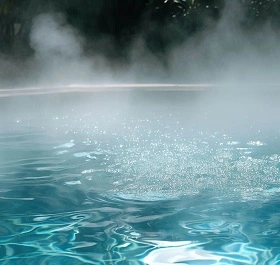Pool Evaporation Calculator

Introducing our innovative Pool Evaporation Calculator – the ultimate tool for pool owners and operators seeking to better understand and manage water loss from their beloved oasis. As any pool owner knows, evaporation can be a significant source of water depletion, leading to the need for frequent refilling and increased water bills. Our Pool Evaporation Calculator takes the guesswork out of this equation by providing an accurate estimation of water loss based on various factors such as pool size, temperature, humidity, wind speed, and sunlight exposure.
With its user-friendly interface and precise calculations, our calculator empowers pool enthusiasts to make informed decisions about water conservation and maintenance, ensuring a more sustainable and cost-effective pool ownership experience. Say goodbye to water waste and hello to optimal pool management with our cutting-edge Pool Evaporation Calculator.

Our Pool Evaporation Calculator is designed to provide you with an accurate estimation of the evaporation rate for your pool, allowing you to better understand and manage water loss. Let's take a closer look at how the calculator functions based on the provided JavaScript code:
The calculator performs a series of calculations based on the input values to determine the estimated evaporation rate for your pool.
By utilizing our Pool Evaporation Calculator, you gain valuable insights into the amount of water lost due to evaporation, helping you manage your pool more effectively and efficiently. Say goodbye to water waste and hello to informed pool maintenance with our user-friendly calculator.
There are several factors that contribute to pool evaporation:
Pool evaporation refers to the process by which water from a pool is converted into water vapor and escapes into the surrounding atmosphere. As the pool water is exposed to air and heat, some of its molecules gain enough energy to break free from the liquid and form water vapor. This vapor then rises into the air, resulting in the loss of water from the pool.
Chlorine, as a disinfectant, is primarily responsible for sanitizing the pool water by killing bacteria and algae.
Several measures can help reduce pool evaporation:
The amount of water that evaporates from a pool each day can vary based on numerous factors, including the pool's surface area, temperature, humidity, wind speed, and sun exposure. Generally, pools can lose anywhere from 1/4 inch to 1/2 inch (0.6 cm to 1.3 cm) of water per day due to evaporation. However, it's important to note that these are rough estimates, and actual rates may differ depending on the aforementioned factors.
To get a more accurate measurement of water loss due to evaporation, you can use a pool cover to minimize the effects of evaporation and install a pool water level monitor to track the changes over time. Additionally, factors like pool usage, splashing, and leaks should be considered when assessing overall water loss in a pool. Regular monitoring and proper maintenance can help ensure the pool water level remains balanced.
Determining whether water loss is due to evaporation or a leak can be challenging. A simple bucket test can help you differentiate between the two. Fill a bucket with water and place it on the pool step or ledge, ensuring it is at the same water level as the pool. Mark the water level inside the bucket and on the pool wall. After 24 hours, compare the water loss in the bucket with the pool water loss. If the pool water loss is significantly higher than the bucket, it may indicate a leak.
Yes, using a pool cover is highly effective in reducing evaporation. A pool cover acts as a barrier, preventing direct exposure of the pool water to air and limiting heat transfer. This helps to minimize evaporation and conserve water. Additionally, a pool cover can also provide other benefits like reducing heat loss, preventing debris from entering the pool, and potentially lowering chemical and energy usage.
Besides using a pool cover, there are several best practices to reduce pool evaporation:
Humidity plays a role in pool evaporation. Lower relative humidity creates drier air, which has a higher capacity to absorb moisture, leading to increased evaporation. In areas with low humidity, pool evaporation rates tend to be higher. Conversely, in regions with high humidity, where the air is already saturated with moisture, evaporation rates may be lower. However, other factors such as temperature and wind speed can still influence evaporation rates.
Estimating the amount of water lost to evaporation in a pool can be challenging due to various factors at play. However, you can make a rough estimate by measuring the change in water level over time. By regularly monitoring and recording the pool's water level, you can calculate the average daily or weekly water loss. Keep in mind that factors like temperature, wind speed, humidity, and pool characteristics will affect the evaporation rate, so this estimate will provide a general idea rather than an exact measurement.